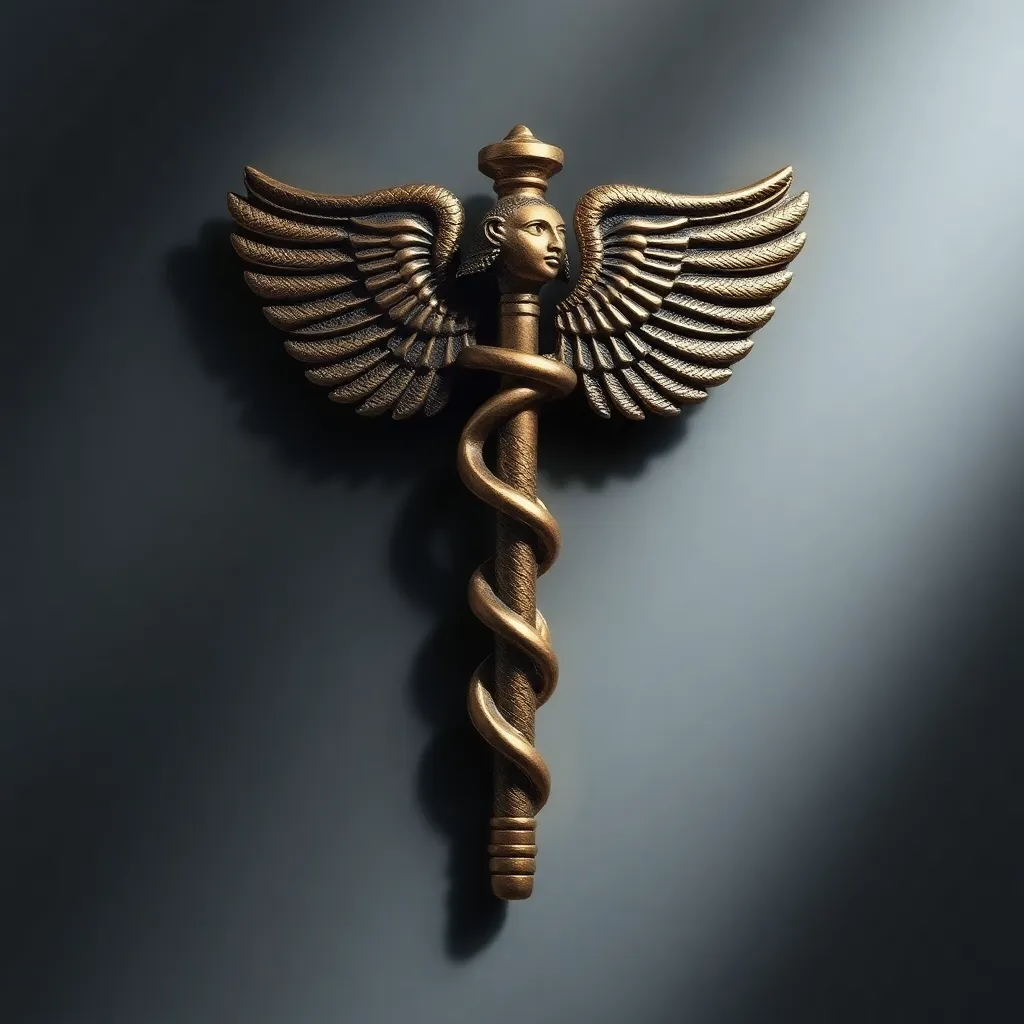The Symbolism of the Caduceus in Egyptian Amulets
I. Introduction
The caduceus, often depicted as a staff entwined by two serpents and topped with wings, has a rich historical significance that spans across various cultures. This symbol has been associated with commerce, negotiation, and balance; however, its roots in ancient Egypt provide a fascinating lens through which to explore its deeper meanings. Egyptian amulets, which were worn for protection and spiritual guidance, played a crucial role in the daily lives of ancient Egyptians, embodying their beliefs and rituals.
This article aims to delve into the symbolism of the caduceus as it appears in Egyptian amulets, examining its historical context, its role in mythology, and its significance in ancient Egyptian society.
II. Historical Context of the Caduceus
The origins of the caduceus can be traced back to ancient civilizations, where it was often depicted in various forms. Initially associated with the trade and commerce of the Mesopotamians, the symbol found a new identity in Greek mythology.
In Greek culture, the caduceus was associated with Hermes, the messenger of the gods, who was often depicted carrying the staff. This connection to Hermes emphasized themes of duality and balance, which are integral to the symbolism of the caduceus.
As the caduceus transitioned into Egyptian culture, it adapted to represent the unique beliefs and values of the Egyptian people, intertwining with their rich tapestry of mythology and spirituality.
III. The Caduceus in Ancient Egyptian Beliefs
In ancient Egyptian beliefs, the caduceus held a multifaceted role within mythology. It symbolized not only trade and negotiation but also the duality of life and death. The two serpents wrapping around the staff represented the balance between opposing forces, such as good and evil, life and death, and chaos and order.
Furthermore, the caduceus was often connected to deities such as Thoth, the god of wisdom and writing, who was believed to guide souls in the afterlife. This connection reinforced the caduceus’s role as a symbol of protection and guidance in both life and death.
IV. The Design and Materials of Caduceus Amulets
Caduceus amulets were crafted from various materials, reflecting the resources available in ancient Egypt. Common materials included:
- Gold
- Silver
- Bronze
- Faience
- Stone
These amulets often featured intricate designs, with depictions of the serpents, wings, and sometimes inscriptions of spells or prayers. The designs varied significantly over different periods of Egyptian history, often reflecting the prevailing artistic styles and religious beliefs of the time.
V. Symbolic Meanings of the Caduceus
The caduceus was imbued with a variety of symbolic meanings in ancient Egypt:
- Health and healing: The caduceus was believed to possess healing properties, often worn by individuals seeking health and vitality.
- Protection: The amulet served as a protective charm against evil spirits and malevolent forces, safeguarding the wearer from harm.
- Afterlife significance: In funerary practices, the caduceus symbolized the journey of the soul and the protection offered by deities in the afterlife.
VI. The Caduceus in Daily Life and Rituals
In ancient Egyptian daily life, caduceus amulets were commonly worn by individuals as a form of protection and as a symbol of their status. The presence of such an amulet often indicated wealth and a connection to the divine.
Rituals and ceremonies involving the caduceus included:
- Healing rituals where the caduceus was invoked to aid the sick.
- Funerary rites, where the amulet was placed with the deceased to ensure safe passage to the afterlife.
- Protection ceremonies, where the caduceus was used to ward off evil spirits during significant life events.
The caduceus, therefore, not only served a personal function but also influenced social status and identity within the community.
VII. Comparative Analysis: Caduceus in Other Cultures
The caduceus shares similarities with symbols from other cultures that represent healing and protection. For instance:
- In Hinduism, the Nāga (serpent) symbolizes fertility and protection.
- The Rod of Asclepius in Greek culture, a single serpent wrapped around a staff, represents medicine and healing.
- In Mesoamerican cultures, serpents often symbolize rebirth and renewal.
While these symbols share common themes, their interpretations can differ significantly based on cultural contexts and religious beliefs. The global influence of the caduceus extends beyond ancient Egypt, influencing modern medical symbols and practices.
VIII. Conclusion
In summary, the caduceus holds profound significance in Egyptian amulets, representing themes of health, protection, and the balance of life and death. Its roots in ancient mythology and its adaptation within Egyptian culture illustrate the importance of symbols in understanding historical contexts. The enduring legacy of the caduceus continues to resonate in modern symbolism, reminding us of the intricate connections between cultural beliefs and their manifestations in art and ritual.
By exploring the caduceus’s role in ancient Egypt, we gain valuable insights into the complexities of their spiritual beliefs and the significance of understanding cultural symbols in a broader historical context.




